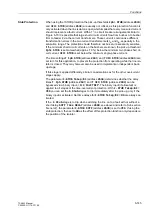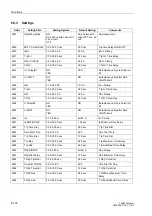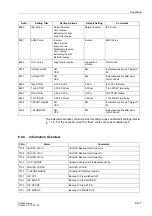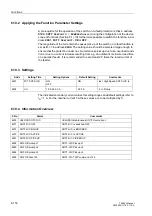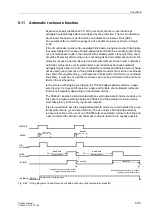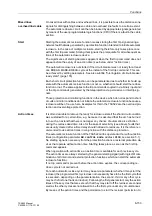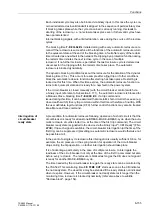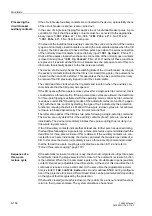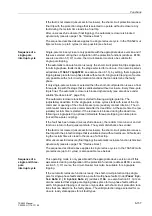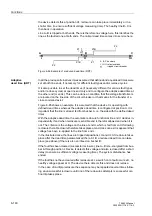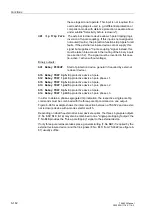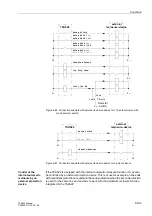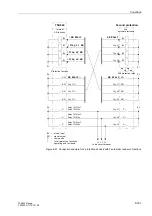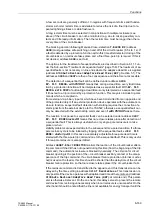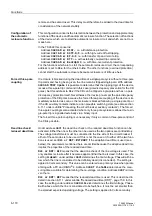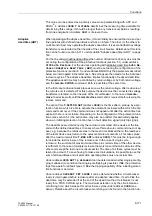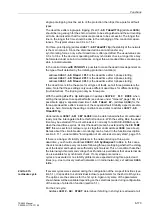
Functions
6-158
7SA522 Manual
C53000-G1176-C119-2
The automatic reclosure function is started in the event of a trip. Depending on the
type of fault the (adjustable) dead time for the single-pole reclose cycle or the (sepa-
rately adjustable) dead time for the three-pole reclose cycle starts following the reset
of the trip command or opening of the circuit-breaker (pole). After expiry of the dead
time the circuit-breaker receives a close command. At the same time the (adjustable)
reclaim time is started. If the reclosure is blocked during the dead time following a sin-
gle-pole trip, optional immediate three-pole tripping can take place (forced three-pole
coupling).
If the fault is cleared (successful reclosure), the reclaim time expires and all functions
return to their quiescent state. The system disturbance has ended.
If the fault is not cleared (unsuccessful reclosure), the short-circuit protection initiates
a final three-pole trip with the protection stage that is valid/selected when reclosure is
not ready. All faults during the reclaim time also lead to the issue of a final three-pole
trip.
After unsuccessful reclosure (final tripping) the automatic reclosure function is blocked
dynamically (see also page 154, "Reclose block").
The sequence above applies for single reclosure cycles. In the 7SA522 multiple reclo-
sure (up to 8 cycles) is also possible (see below).
Multiple reclosure
If a short-circuit still exists after a reclosure attempt, further reclosure attempts can be
made. Up to 8 reclosure attempts are possible with the automatic reclosure function
integrated in the 7SA522.
The first four reclosure cycles are independent of each other. Each one has separate
action and dead times, can operate single or three pole and can be blocked separately
via binary inputs. The parameters and intervention possibilities of the fourth cycle also
apply to the fifth cycle and onwards.
The sequence is the same in principle as in the different reclosure programs described
above. However, if the first reclosure attempt was unsuccessful, the reclosure function
is not blocked, but instead the next reclose cycle is started. The appropriate dead time
starts with the reset of the trip command or opening of the circuit-breaker (pole) (aux-
iliary contact criterion). The circuit-breaker receives a new close command after expiry
of the dead time. At the same time the reclaim time is started.
Until the set number of permissible reclose cycles is reached, the reclaim time is reset
with each new trip command after reclosure and started again with the next close com-
mand.
If one of the cycles is successful, i.e. the fault no longer exists after reclosure, the re-
claim time expires and all functions return to their quiescent state. The system distur-
bance has ended.
If none of the cycles is successful, a final three-pole trip is issued by the valid protec-
tion stage selected to operate during the recloser not ready state following the final
permissible reclosure. The automatic reclosure is blocked dynamically (see also "Re-
close block", page 154).
Treatment of
sequential faults
When single-pole and single and three-pole reclose cycles are executed in the
network, particular attention must be paid to sequential faults.
Sequential faults are faults which occur during the dead time after clearance of the first
fault.
There are various ways of handling sequential faults in the 7SA522 depending on the
requirements of the network:
Summary of Contents for siprotec 7SA522
Page 20: ...7SA522 Manual C53000 G1176 C119 2 ...
Page 64: ...7SA522 Manual C53000 G1176 C119 2 ...
Page 89: ...SIPROTEC 4 Devices 4 25 7SA522 Manual C53000 G1176 C119 2 Figure 4 20 CFC Logic example ...
Page 408: ...7SA522 Manual C53000 G1176 C119 2 ...
Page 456: ...7SA522 Manual C53000 G1176 C119 2 ...
Page 516: ...7SA522 Manual C53000 G1176 C119 2 ...
Page 620: ...Appendix B 48 ...


